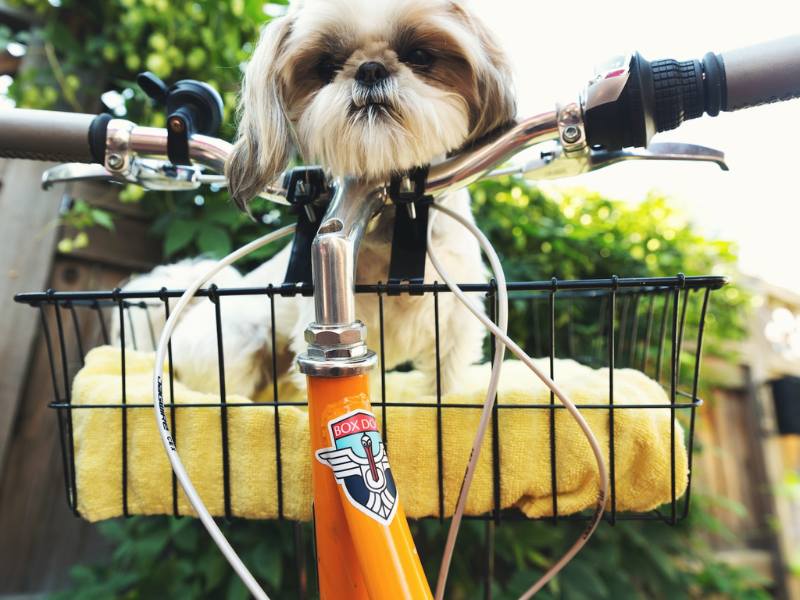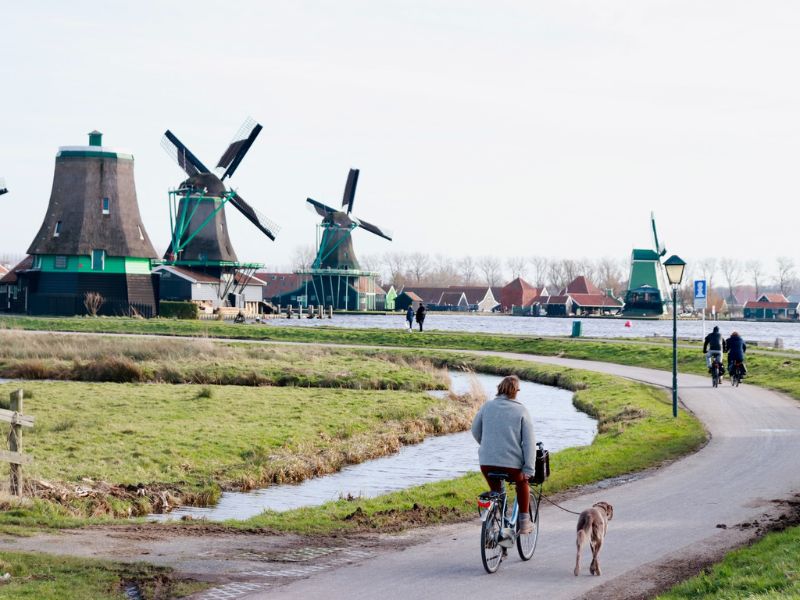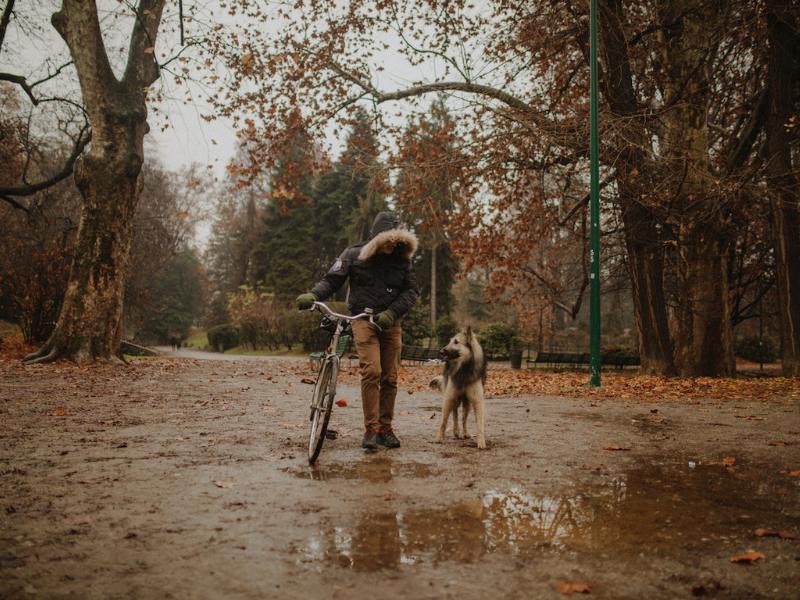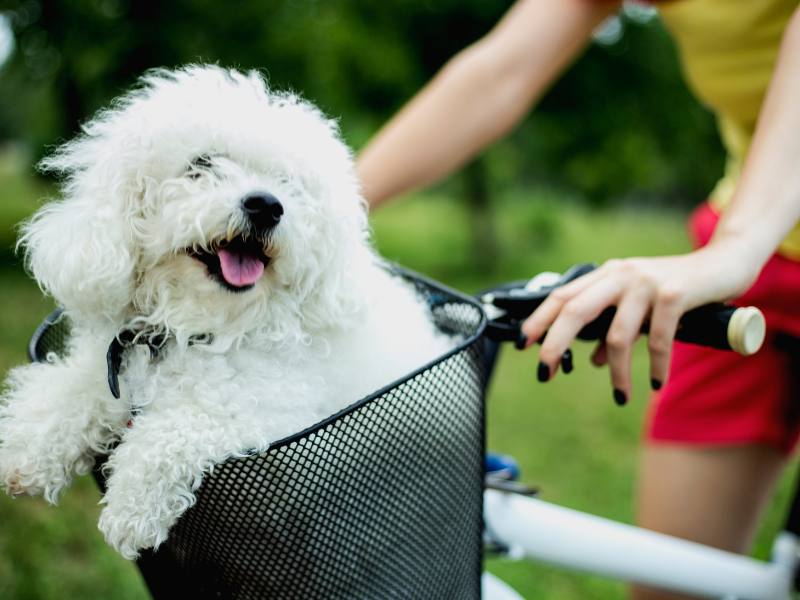Last Updated on 2 August 2023 by Cycloscope

Biking with your dog can be a lot of fun and a great way to bond with your buddy. Learn all about safety essentials so you and your pet have a good time!
Take your Dog on a Bike Ride: Tips And Safety Advice
Disclosure: Some of our articles contain affiliate links. This comes at no additional cost for you and helps us keep this website up and running. (as Amazon Associates we earn commission from qualifying purchases)

Cycling with your dog is an exciting and fun way to spend time with your best bud. Not only is it great for getting some exercise and fresh air, but you also get to spend quality time with your furry friend — perfect for bonding with your pup while adding an interesting spin on your usual walks!
But before you get ahead of yourself and start thinking of mountain biking with your pet, remember that there’s a lot that goes into taking your dog along for a bike ride.
Let’s explore how to bike with your dog with some safety advice and tips to make your day out safer and more fun!
Choosing The Right Equipment For Bike Rides With Your Dog

A major aspect of responsibly biking with a dog is to ensure that you have all the necessary tools to make your trip safe for you, your dog, and other pedestrians or bikers. Without the right equipment, you run the risk of falling over, injuring your dog, or dashing into other people.
Here are some essentials you should have before you hit the road.
Biking with a dog leash
A bike leash is often longer than a normal leash as it is designed to keep your dog at a safe distance from your bike. This will prevent them from getting tangled up by running into the wheels, which can injure both you and your pup.
The leash is typically attached to your bike’s frame or seat post and will give your dog enough leeway to run comfortably alongside you, without getting too close or straying too far.
Harness
A harness is a great alternative to a collar in a lot of situations. It is also a safer option as it ensures that the pressure from the leash is evenly distributed across the dog’s chest and pack. This reduces the risk of injury while biking while providing more control over the dog’s movements.
Bike Attachment
A bike attachment is a piece of equipment that creates a safe distance between your bike and your dog. It’s typically attached to the bike’s frame or seat and helps prevent your dog’s leash from getting tangled in the wheels of your bike. It also prevents them from wandering into oncoming traffic.
Portable Bowl, Water, And Treats
Whether you’re planning for a quick bike ride around the neighborhood or a longer one, your dog is likely to get thirsty. So, it’s always good to be prepared to reduce the risk of dehydration.
Carry a portable dog bowl and plenty of water for you and your dog. You can find all kinds of portable, collapsible dog bowls on the market, they are designed to be compact so you can optimize on space and functionality. You should also consider carrying a portable pee pad like doggielawn so your dog can do its business.
And remember to carry treats to reward your dog for good behavior. It will also encourage them to stay focussed on you while you’re out biking.
Why Having A Proper Bike Is Important: Factors To Consider

The most important thing when you want to go biking with a dog is obviously the bike.
Your bike will affect how easily you can ride with your dog alongside you and can impact the overall safety, comfort, and enjoyment of your adventure.
Here are some factors to consider to ensure that you have the right bike to safely go biking with your four-legged friend:
Comfort
The most important factor when selecting a bike, even for personal use, is how comfortable you are riding it for extended periods of time. And when you add a dog to the equation, your comfort is especially important. When biking, you won’t have to adjust your position or constantly fidget, which may cause issues with balance and could also make your dog uncomfortable.
Stability
Riding a bike with a dog tethered to it can dramatically impact the bike’s stability. So, if a bike feels unstable when you are riding alone, this will be amplified when riding bike with dog. An unstable bike can cause you to fall and hurt yourself, run into your dog and wound them while trying to balance, or even become a hazard to other pedestrians or bikers. A stable bike is thus of utmost importance.
Weight Capacity
Check your bike’s weight limit before you go biking with your dog. It should have a weight capacity to safely support both your weight and your dog’s weight, especially if your dog enjoys riding in the basket or in a dog seat behind.
Opt for a bike that will support your and your dog’s weight at the very least, but preferably maintain a margin in case you wish to carry some extra things along. Keep in mind that even the weight of your water bottles, treats, snacks, and portable dog bowl can add up. So, you want to ensure that you have some leeway in terms of your bike’s weight capacity.

Types of Tires and Additional Features
Different terrains require different tires. For example, if you will be riding on rough terrain, you may need a bike with wider tires with more tread, and if you’re going to bike on the beach, you may need beach-friendly tires.
Also ensure that your bike can hold additional dog-friendly extensions such as a basket, dog seat, storage bag, etc. This way, you have the freedom to use attachments as and when needed, depending on where you will be biking with your dog.
Brakes and Brake Extenders
Brakes are an extremely crucial factor when biking. If you already own a bike, get the brakes checked or serviced to ensure that they are functional. If you’re purchasing a new bike, check the brakes to make sure that they are reliable and easy to operate. You can also add a brake extender to give you more leverage, as an added safety precaution.
Introducing Your Dog To Biking: Training and Tips
Before you hit the open road with your dog, you have to introduce them to the concept of biking and ease them into it.
Here are some tips to help you kick-start your journey:
Familiarize Your Dog With The Equipment
Biking equipment can seem new and daunting to dogs if they aren’t familiar with it. Let your dog get accustomed to your equipment before you start biking together. Allow it to sniff around and explore your biking equipment, and if you have a dog basket or seat, let it get comfortable with it.
Once you’re confident your dog is accustomed to all your biking equipment, you can start taking them out for trial runs.
Start Out Slow
When introducing your dog to biking, it’s important to start slow and take baby steps. Begin with short, slow rides around the neighborhood so your dog has the chance to get used to the bike and the sensation of running along while you ride. Then you can gradually increase the duration and intensity of your rides once your dog begins to get comfortable with the concept.
Biking Commands
Before you hit the road, make sure you can effectively communicate with your dog with biking commands. Train them to follow instructions such as “step” and “stay” so you can maintain control while riding and ensure your dog’s safety.
Positive Reinforcement
As is the case with teaching your dog any new activity, providing your dog with positive reinforcement is important. Offer treats, praises, and pets in abundance, so your dog feels encouraged and rewarded for its good behavior. It will also encourage your pup to stay focused on you, which is always a good thing when you’re out on the road.
Use A Safe and Controlled Environment
Before you head out onto a busy street or mountainous terrain, practice riding in a safe and controlled environment, such as an empty parking lot or a quiet park. You can then try to get your dog accustomed to the more outdoorsy biking experiences you have planned.
Safety Precautions For Biking With A Dog

It’s important to take certain safety precautions to ensure that you can safely bike with your dog while reducing the risk of mishaps. Here are some things to keep in mind:
- Choose safe routes and avoid busy roads, crowded trails, or areas with heavy traffic.
- Use bright, reflective clothing and a dog collar or vest to ensure that other cyclists or motorists can easily see you and your dog.
- Monitor your dog at all times, and use commands to bring it back to your side if it gets distracted or tries to wander off.
- Keep an eye out for potential hazards and be prepared for emergencies by keeping a first aid kit handy at all times.
- Take breaks every 30 minutes or so to let your dog rest and hydrate. You can also use this time to stretch your limbs.
Wrap Up about biking with a dog
Going for bike rides with your dog can be an extremely enriching experience for both of you. It can enhance your bond, help you spend quality time together, and allow you to explore your neighborhood! And with the right equipment, preparation, and safety precautions in place, you’re all set to have a wonderful adventure together!



